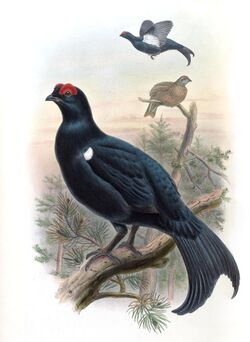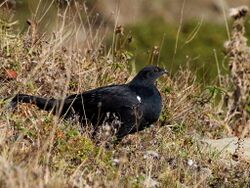Biology:Caucasian grouse
| Caucasian grouse | |
|---|---|

| |
| Scientific classification | |
| Domain: | Eukaryota |
| Kingdom: | Animalia |
| Phylum: | Chordata |
| Class: | Aves |
| Order: | Galliformes |
| Family: | Phasianidae |
| Genus: | Lyrurus |
| Species: | L. mlokosiewiczi
|
| Binomial name | |
| Lyrurus mlokosiewiczi (Taczanowski, 1875)
| |
| Synonyms | |
|
Tetrao mlokosiewiczi | |
The Caucasian grouse or Caucasian black grouse (Lyrurus mlokosiewiczi) is a large bird in the grouse family. It is closely related to the black grouse (L. tetrix).
Description
As with many gamebirds, the cock (male) is larger than the hen (female), measuring 50–55 cm compared to her length of 37–42 cm. The cock is very distinctive, with all-black plumage, apart from red eyebrows, and a long, deeply forked tail. The female Caucasian grouse is grey with dark barring, and has a cackling call.[2]
Distribution and habitat
It occurs in extreme southeastern Europe and adjacent regions.[3][4] The scientific name of this bird commemorates the Polish naturalist Ludwik Mlokosiewicz. The Caucasian grouse is a sedentary species, breeding in the Caucasus and Pontic Mountains of northeast Turkey and iran on open slopes with low Rhododendron or other scrubs but in proximity to deciduous broad-leaf forest.[4]
Breeding
They have a group display or lek in May and June. Unlike the male Eurasian black grouse, the Caucasian grouse display is almost mute but for a thin whistling of the cock fluttering his wings as he leaps and turns in the air, producing a flash of white as the underwing feathers are briefly revealed.[2] The hen lays up to ten eggs in a ground scrape and takes all responsibility for nesting and caring for the chicks, as is typical with gamebirds.
Conservation
It is perhaps the least-studied of all grouse in the world, and it was formerly classified as Data Deficient by the IUCN.[1][5] Recent research shows that it is declining to some extent, and it is consequently listed as a Near Threatened species in 2008[6] with an estimated population of 30,203–63,034 worldwide in 2010.[4] Conservation efforts have included encouraging ecotourism as a way to promote awareness of the bird and its habitat.[7]
References
Notes
- ↑ 1.0 1.1 BirdLife International (2016). "Lyrurus mlokosiewiczi". IUCN Red List of Threatened Species 2016: e.T22679483A92815595. doi:10.2305/IUCN.UK.2016-3.RLTS.T22679483A92815595.en. https://www.iucnredlist.org/species/22679483/92815595. Retrieved 11 November 2021.
- ↑ 2.0 2.1 Madge et al. (2002)
- ↑ Gokhelashvili, R.; Kerry, P.R.; Gavashelishvili, L. (2003). "How much do we know about the Caucasian Black Grouse Tetrao mlokosiewiczi". Sandgrouse 25 (1): 33–40.
- ↑ 4.0 4.1 4.2 Gavashelishvili, A.; Javakhishvili, Z. (2010). "Combining radio-telemetry and random observations to model the habitat of Near Threatened Caucasian grouse Tetrao mlokosiewiczi". Oryx 44 (4): 491–500. doi:10.1017/S0030605310000979.
- ↑ BLI (2004)
- ↑ BLI (2008)
- ↑ "Doga Dernegi Caucasian Black Grouse Project". http://www.dogadernegi.org/daghorozu/cbgen.php.
Bibliography
- BirdLife International (BLI) (2008): [2008 IUCN Redlist status changes]. Retrieved 2008-MAY-23.
- Madge, Steve; McGowan, Philip J. K. & Kirwan, Guy M. (2002): Pheasants, partidges and grouse : a guide to the pheasants, partridges, quails, grouse, guineafowl, buttonquails and sandgrouse of the world. Christopher Helm, London. ISBN:0-7136-3966-0
- Gokhelashvili, R.; Reese, K. P.; Gavashelishvili, L. 2003. How much do we know about the Caucasian Black Grouse Tetrao mlokosiewiczi? Sandgrouse 25: 33–40.
- Caucasian Grouse (BirdLife International)
Wikidata ☰ Q845408 entry
 |



